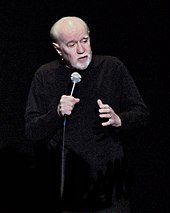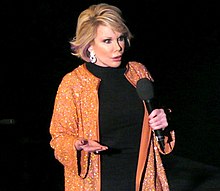| Stand-up comedy | |
|---|---|
 George Carlin performing in 2008 |
| Part of a series on |
| Performing arts |
|---|
Stand-up comedy is a form of comedy performance directed to a live audience, where the performer stands on a stage and delivers humorous and satirical monologues sometimes incorporating physical acts. These performances are typically composed of rehearsed scripts but often include varying degrees of live crowd interaction. Stand-up comedy consists of one-liners, stories, observations, or shticks that can employ props, music, impressions, magic tricks, or ventriloquism.
A performer in this genre can be known by the masculine and gender-neutral terms stand-up comedian and stand-up comic, or by the feminine term stand-up comedienne. Performances can take place in various venues, including comedy clubs, comedy festivals, bars, nightclubs, colleges, or theaters. [citation needed][1]
Stand-up comedy originated in various traditions of popular entertainment of the late 19th century. These include vaudeville, the stump-speech monologues of minstrel shows, dime museums, concert saloons, freak shows, variety shows, medicine shows, American burlesque, English music halls, circus clown antics, Chautauqua, and humorist monologues, such as those delivered by Mark Twain in his 1866 touring show Our Fellow Savages of the Sandwich Islands.[2][3]
Charles Farrar Browne (April 26, 1834 – March 6, 1867), better known by his nom de plume, Artemus Ward, is considered America's first stand-up comedian. His character, portrayed as an illiterate rube with "Yankee common sense," was portrayed publicly by Browne.
The first documented use of "stand-up" appeared in The Stage in 1911, describing a woman named Nellie Perrier delivering 'stand-up comic ditties in a chic and charming manner'. However, this referred to a performance of comedy songs rather than stand-up comedy in its modern form.[4]
The term appeared again in the “Stage Gossip” column of The Yorkshire Evening Post on November 10, 1917. The article discussed the career of a comedian Finlay Dunn, stating that Dunn was "what he calls a stand-up comedian'" during the latter part of the 19th century, although the term may have been used retrospectively.[5]

Stand-up has multiple genres and styles with their formats. Common ones include:

In a typical stand-up show, the host, compere, or emcee "warms up" the audience and introduces the other performers. This is followed by the opener, the feature, and then the headliner. The host may also act as the opener for smaller shows.[10] Proven comics tend to earn regular bookings at clubs that are part of a chain and comedy venues. Jobbing stand-ups may perform sets at two or more venues on the same day.[citation needed]
Clubs and small venues often run open mic events; these slots may be booked in advance or left for walk-ins. Comedians use open mics to work on material or to show off their skills to get an opener slot.[11] "Bringer shows" are shows that require amateur performers to bring a specified number of paying guests with them to receive stage time.[12]
As well as being a mainstay of the comedy circuit, festivals often also showcase up-and-coming acts, with promoters and agents using the festivals to seek out new talent.[13]
Experienced comics with a following may produce a television special or a comedy album. It may be recorded on tour or at a show advertised and performed specifically for the purpose. A TV special originally released on television, video on demand, or film theaters may be re-released as an album on audio CD, LP record or audio streaming. A "half-hour special" is typically between 20 and 35 minutes in runtime excluding commercial breaks and an "hour-long special" is typically between 40 and 65 minutes excluding commercial breaks.[14]

Stand-up comedians define their craft through the development of routines, which they construct and refine with jokes and interconnected "bits." These bits form an interwoven narrative, leading to the "closer," the final joke that ties the show's themes together for a satisfying conclusion.
Most jokes are the juxtaposition of two incongruous things and are made up of the premise, set-up, and punchline, often adding a twist, topper or tagline for an intensified or extra laugh. Delivery relies on the use of intonation, inflection, attitude and timing as well as other stylistic devices, such as the rule of three, idioms, archetypes or wordplay.[15][16] Another popular joke structure is the paraprosdokian, a surprising punchline that changes the context or meaning of the setup.[17]
In order to falsely frame their stories as true or to free themselves of responsibility for breaking social conventions, comedians can use the jester's privilege, which is the right to discuss and mock anything freely without being punished.[18][19] Social commentators have referred to the concepts of "punching up" and "punching down" in attempting to describe who should be the "butt of the joke". This carries the assumption that, relative to the comedian's own socio-political identity, comedy should "punch up" at the rich and powerful without "punching down" at those who are marginalized and less fortunate.[20][21] Many comedians have criticized the cultural rhetoric concerning "punching up" and "punching down", including Colin Quinn, who described the terms as a product of activism and "not created by humorous people."[22]
Appropriation and plagiarism are considered "social crimes" by most stand-ups. There have been several high-profile accusations of joke theft, some ending in lawsuits for copyright infringement. Those accused will sometimes claim cryptomnesia or parallel thinking,[23][24] but it is difficult to successfully sue for joke theft regardless due to the idea–expression distinction.[25]

According to Anna Spagnolli, stand-up comedy audiences "are both 'co-constructors of the situation' and 'co-responsible for it'".[26]
In stand-up comedy, an unspoken contract with the audience allows for the exploration of unexpected, controversial, or scandalous subjects. The reception of a joke, whether met with laughter or disapproval, hinges on the audience's understanding of the premise and appreciation of the punchline. A seasoned comic is able to instantly react to the audience's reaction and use it to further their narrative.
Stand-up comedy, distinct from traditional performing arts, features a lone comedian directly engaging the audience. Success hinges on creating spontaneity, fostering intimacy, and deterring heckling.
Part of the appeal of stand up is in appreciation of the skill of the performer, as studies have shown that many people find the idea of standing on stage daunting; research on the subject has consistently found that the fear of public speaking is more intense than the fear of dying.[27][28]
The audience is integral to live comedy, both as a foil to the comedian and as a contributing factor to the overall experience. The use of canned laughter in television comedy reveals this, with shows often seeming "dry" or dull without it. Shows may be filmed in front of a live audience for the same reason.[29]

Phyllis Diller holds the Guinness World Record for most laughs per minute, with 12.[34]
Taylor Goodwin holds the Guinness World Record for most jokes told in an hour with 550.[35]
Lee Evans sold £7 million worth of tickets for his 2011 tour in a day, the biggest first-day sale of a British comedy tour.[36]
Ricky Gervais set a new Guinness World Record for the highest gross from a single stand-up performance with his tour "Armageddon." The performance at the Hollywood Bowl in Los Angeles, California, on May 6, 2023, garnered a notable sum of £1,410,000 ($1,790,206.50)[37]
British comedian Peter Kay currently holds multiple records for his 2010-2011 show The Tour That Doesn't Tour Tour...Now On Tour on a 112 date UK & Ireland arena tour.
Observational comedy works by mocking 'normal' behaviours but, even as it does so, it often affirms and promotes a fixed idea of what 'normal' is.
On this circuit, shows generally consist of three to four comics: Headliner, Feature act, Opener and/or Emcee (i.e., Master of Ceremonies). The Headliner does roughly an hour of original material. The Feature act does 25-30 minutes. The Opener has a ten minute slot, and the Emcee squeezes in a joke or two between acts (if the Opener is not also acting as the Emcee)...
Open mikes are where, as a comedian [like Daniel Tosh and his controversy], you're supposed to be allowed to fuck up.
Go to festivals, because that's where you get noticed by the media ... [and] gauge [yourself against] everybody else.
Eddie Izzard states, 'it should be—establish, reaffirm, and then you kill it on the third... you can keep reaffirming before you twist.
it is useful to examine the famous paraprosdokian, 'I've had a wonderful evening, but this wasn't it.'
the comedy of the left 'punches up' at the established authorities of its time, be they governmental, cultural, or artistic. ... a joke is a joke, not a political act, and the ability to say what you like in the context of joking is held sacred.
George Carlin echoed this sentiment, observing that 'comedy has traditionally picked on people in power.' … '[Chappelle and Gervais] have done daring and subversive work on other topics, like race and religion, respectively, but punching down at an essentially powerless minority group is pure hack.'
[T]here are also cases of simple coincidence and, often in the case of observational material, parallel thinking.
Just because it is small, they call it a chi-chi room, or because they bring certain oddball forms of entertainment
If you have an all 'A' [material] 5-minute set, you'll get paid nothing.
[Phyllis Diller] still holds the Guinness Book of World Records for doling out 12 punch lines a minute.
| Topics | |||||||||||
|---|---|---|---|---|---|---|---|---|---|---|---|
| Film |
| ||||||||||
| Theatre |
| ||||||||||
| Media | |||||||||||
| Subgenres | |||||||||||